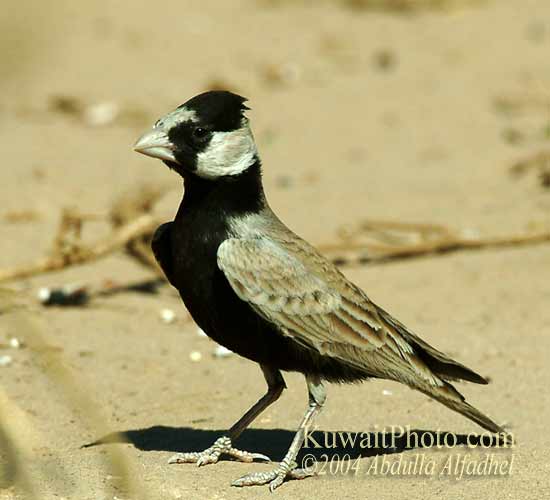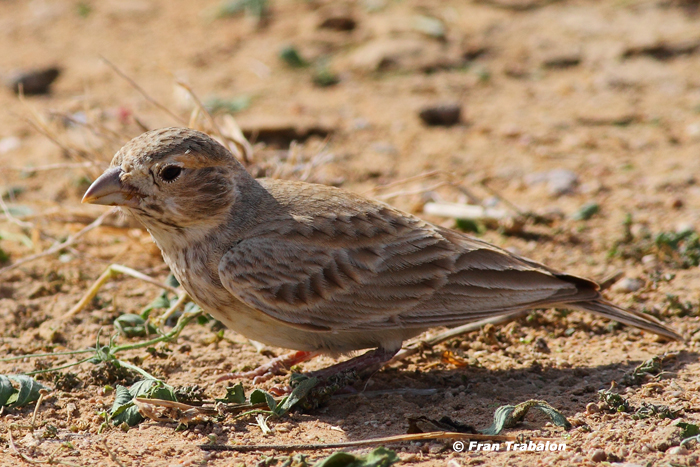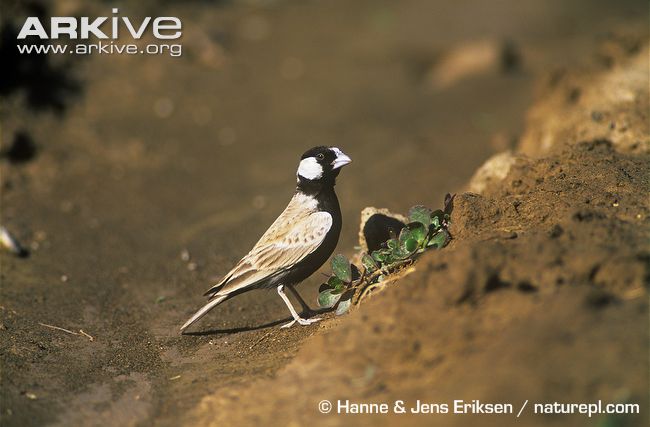
Eremopterix nigriceps
TAXONOMY
Pyrrhalauda nigriceps Gould, 1841, Sгo Tiago, Cape Verde Islands.
OTHER COMMON NAMES
English: Black-crowned finch-lark, pallid finch-lark; French:
Moinelette а frout-blanc; German: WeiЯstirnlerche; Spanish:
Aloudra gottiуn de Corouna Negra.
PHYSICAL CHARACTERISTICS
4.5–4.9 in (11.5–12.5 cm); male 0.5–0.6 oz (14–16 g); female 0.4
oz (12 g); one of the smallest lark species. Sparrow-larks, like
finches or sparrows, have a proportionally large head and a
strong conical bill. Sexes are dimorphic with respect to plumage
color. Female mainly pale brown and streaked, male with white
forehead, cheeks, sides of neck, and collar of nape. Crown,
stripe through eye to base of bill, and lower border of cheek
black. Underparts entirely black, upperparts grayish brown.
DISTRIBUTION
Cape Verde Islands, southern Morocco, northern Mauritania
to western Sahara, southeast Egypt. From North Africa,
through most of the Arabian Peninsula, including Island of
Sokrota, to Pakistan and northwestern India. Expanded its area
to northern Nigeria, possibly due to desertification. Vagrant to
Israel, Jordan, and Algeria.
HABITAT
Semidesert and sandy areas with sparse vegetation, also close to
cultivated land.
BEHAVIOR
Territorial during breeding season, gregarious other times. In
song-flight, male ascends at a 45° angle with legs dangling up
to 66 ft (20 m), then flies in roughly circular paths in an undulating
style to descend in stages. Song also performed from elevated
perch.
FEEDING ECOLOGY AND DIET
Feeds more on seeds than arthropods; de-husks seeds; can
drink salty or brackish water.
REPRODUCTIVE BIOLOGY
Monogamous. Female builds cup-shaped nest, male may also be
involved in nest-building. Rim of nest frequently surrounded by
small lumps of soil or stone. Breeding period irregular; two to
three eggs laid, incubated by both sexes for 11–12 days. Both
parents feed and brood. Young leave nest after eight days before
being able to fly. Each parent cares for one single chick, so
that only two young per brood can be reared (split brood-care).
CONSERVATION STATUS
Not threatened.
SIGNIFICANCE TO HUMANS
None known.
Other popular Animals
Photo Gallery of - Black-crowned sparrow-lark




 Animalia Life
Animalia Life